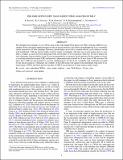| dc.contributor.author | Ignace, R. | |
| dc.contributor.author | Gayley, K. G. | |
| dc.contributor.author | Hamann, W.-R. | |
| dc.contributor.author | Huenemoerder, David P. | |
| dc.contributor.author | Oskinova, Lidia M. | |
| dc.contributor.author | Pollock, A. M. T. | |
| dc.contributor.author | McFall, M. | |
| dc.date.accessioned | 2015-02-04T18:54:04Z | |
| dc.date.available | 2015-02-04T18:54:04Z | |
| dc.date.issued | 2013-09 | |
| dc.date.submitted | 2013-06 | |
| dc.identifier.issn | 0004-637X | |
| dc.identifier.issn | 1538-4357 | |
| dc.identifier.uri | http://hdl.handle.net/1721.1/93755 | |
| dc.description.abstract | We obtained four pointings of over 100 ks each of the well-studied Wolf-Rayet star WR 6 with the XMM-Newton satellite. With a first paper emphasizing the results of spectral analysis, this follow-up highlights the X-ray variability clearly detected in all four pointings. However, phased light curves fail to confirm obvious cyclic behavior on the well-established 3.766 day period widely found at longer wavelengths. The data are of such quality that we were able to conduct a search for event clustering in the arrival times of X-ray photons. However, we fail to detect any such clustering. One possibility is that X-rays are generated in a stationary shock structure. In this context we favor a corotating interaction region (CIR) and present a phenomenological model for X-rays from a CIR structure. We show that a CIR has the potential to account simultaneously for the X-ray variability and constraints provided by the spectral analysis. Ultimately, the viability of the CIR model will require both intermittent long-term X-ray monitoring of WR 6 and better physical models of CIR X-ray production at large radii in stellar winds. | en_US |
| dc.description.sponsorship | United States. National Aeronautics and Space Administration (Smithsonian Astrophysical Observatory contract SV3-73016, Chandra X-Ray Center and Science Instruments) | en_US |
| dc.description.sponsorship | German Aerospace Center (DLR) (grant 50 OR 1302) | en_US |
| dc.language.iso | en_US | |
| dc.publisher | Institute of Physics/American Astronomical Society | en_US |
| dc.relation.isversionof | http://dx.doi.org/10.1088/0004-637X/775/1/29 | en_US |
| dc.rights | Article is made available in accordance with the publisher's policy and may be subject to US copyright law. Please refer to the publisher's site for terms of use. | en_US |
| dc.source | American Astronomical Society | en_US |
| dc.title | THE XMM-NEWTON /EPIC X-RAY LIGHT CURVE ANALYSIS OF WR 6 | en_US |
| dc.type | Article | en_US |
| dc.identifier.citation | Ignace, R., K. G. Gayley, W.-R. Hamann, D. P. Huenemoerder, L. M. Oskinova, A. M. T. Pollock, and M. McFall. “ THE XMM-NEWTON /EPIC X-RAY LIGHT CURVE ANALYSIS OF WR 6 .” The Astrophysical Journal 775, no. 1 (August 30, 2013): 29. © 2013 American Astronomical Society. | en_US |
| dc.contributor.department | MIT Kavli Institute for Astrophysics and Space Research | en_US |
| dc.contributor.mitauthor | Huenemoerder, David P. | en_US |
| dc.relation.journal | Astrophysical Journal | en_US |
| dc.eprint.version | Final published version | en_US |
| dc.type.uri | http://purl.org/eprint/type/JournalArticle | en_US |
| eprint.status | http://purl.org/eprint/status/PeerReviewed | en_US |
| dspace.orderedauthors | Ignace, R.; Gayley, K. G.; Hamann, W.-R.; Huenemoerder, D. P.; Oskinova, L. M.; Pollock, A. M. T.; McFall, M. | en_US |
| mit.license | PUBLISHER_POLICY | en_US |
| mit.metadata.status | Complete | |
